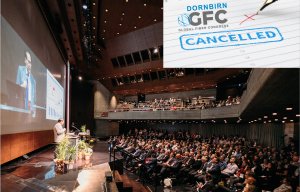
Dornbirn-GFC 2020 cancelled
Opinion


Despite a mountain to climb in creating a sustainable fibre industry, there are reasons for optimism, conference learns.

19th September 2022
Adrian Wilson
|
Dornbirn, Austria
After three years of enforced virtuality, the 2022 Dornbirn Global Fiber Conference (Dornbirn-GFC) very successfully returned as a live event to its traditional venue in the picturesque Alpine valley town in Austria from September 14-16.
Three years in which many things, of course, have changed, but the fact that the 61st Dornbirn-GFC was able to attract some 557 delegates from 32 countries speaks volumes.
Dornbirn is not the easiest place to get to and in a period when there is still in any case much uncertainty about travel – and many businesses have cut travel budgets – the delegates represented 240 global companies from around the world, with the notable exceptions this year being from China and Russia, albeit for very different regions.
“The Dornbirn-GFC has built a solid reputation for quality and in-depth industry analysis, and this year’s meeting reflects a hunger to get back to traditional face-to-face events – and perhaps for a little more global stability,” said Friedrich Weninger, MD of the Austrian Fibers Institute (AUT) in opening the conference. “We have been overwhelmed by the successful support this year, and to be able to attract such a high number of delegates as well as to present 112 in-person lectures and invite many new start-ups into our community is very satisfying. Our organisation showed agility in switching to digital and I think we are now being rewarded for keeping this spirit alive.”
Impacts
Keynote speakers on the first day of the conference highlighted the big picture events that are inevitably impacting on the global fibres industry – and mostly in a negative way.
Both Thomas Riegler, partner at global audit firm PricewaterhouseCoopers (PWC), and Robert van de Kerfhof, managing director of the AUT and Lenzing CCO, expressed their frustration at the fact that after a Covid 19-related fall, CO2 emissions hit a new record of 421ppm in May this year, with Europe experiencing its hottest summer on record.

Riegler questioned the point of the huge sums that are being spent by corporations on both sustainable initiatives and environmental, social and corporate governance (ESG) reporting.
“The problem is that there is no common understanding of what is needed and it is all aimed at making companies feel good rather than doing good,” he said. “All major corporations are claiming to be sustainable yet we are seeing increased emissions and wealth is being created at the expense of more than the planet can provide. Our entire economy is currently based on unsustainable management and behaviour.”
Van de Kerkhoff said that the production of textile garments had doubled in a decade, and current projections showed that another 45 million tons of fibres would be required to meet rising demand by 2030, of which 20% at best would be sustainable.
“We are in a period of consequences and we cannot avoid it,” he said. “The use of fossil fuels is sky high and remains the key driver of the economy, while consumer confidence is on its knees worldwide and there is still an over-dependency on international trade.
“Around five million tons of additional, renewable wood-based fibres will be produced by 2030, and a little more cotton, but the rest will be synthetics. There is a lot of effort going into the establishment of closed loop recycling for synthetics, but the fact that at the moment, only 1% of fibres are being returned to new fibres is frankly embarrassing. Our industry needs renewables.”
Positive measures
Nevertheless, there were concrete examples of how positive measures can be achieved very quickly at Dornbirn 2022, such as the 60,000 ton annual capacity Circulose plant in Sweden that Renewcell commissioned this August, ahead of schedule and having only started construction of it in October 2021.
Circulose is a renewable dissolving pulp made from cotton-rich textile waste that can be turned into new viscose fibres and filaments to allow for a circular textile production system to be established.

The company’s product development engineer Sara Öhman explained that industrial scale-up was made possible by the new technology being in part adapted from the established paper making process in partnership with SCA, with whom Renewcell shares the site of its new plant.
Over 80% of the capacity of the plant has already been reserved by customers, following a series of high profile capsule collections from brands.
There is a similar story of major brand support and capacity off-take at Infinted Fiber Company, which is rapidly converting a shuttered paper mill in Finland for the production of 30,000 tons of its Infinna fibre by 2025.
CEO Petri Alava explained that Infinited’s technology turns cellulose-based raw materials, like cotton-rich textiles, used cardboard or rice or wheat straw, into a unique, premium textile fibre with the natural, soft look and feel of cotton.
Monomaterials
The case for monomaterial garments and designing for recycling as the only way to effectively combat fast fashion is also becoming stronger all the time.
A conference session focused on the existing and upcoming recycling technologies for fibres, with speakers from Erema, Gneuss and Rieter, underlined the difficulties of dealing with mixed fibre textile waste, as well as highlighting the future shortage of recycled PET polyester for textile manufacturing, as PET bottle companies absorb existing capacities.
An inspiring success story of how Cradle to Cradle Gold certification was achieved for the entire supply chain behind a monomaterial jacket produced in Italy for the VF Corporation brand Napapijiri was presented, and will be the subject of one of a series of further reports from Dornbirn on Innovation in Textiles.
The conference presentations are available to view online, on-demand until October 2nd.

Business intelligence for the fibre, textiles and apparel industries: technologies, innovations, markets, investments, trade policy, sourcing, strategy...
Find out more